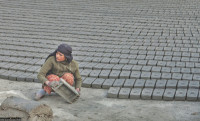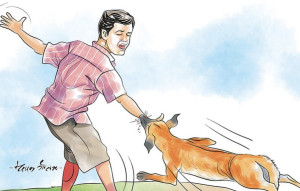Columns
An answer to food insecurity
Reclaiming land has traditionally been a way of adapting to the fury of nature..JPG&w=900&height=601)
Madhukar Upadhya
Scientists seldom use alarmist language when publishing their findings, opting instead for a more neutral and academic tone. However, when they do, we must heed their warnings, especially concerning the rapidly unfolding consequences of climate change. Many of the events and concerns outlined by existing climate models have been spot on so far. Furthermore, a recently published article has revealed how the possibility of simultaneous crop failures worldwide has been underestimated because of a lack of understanding about the types of climate extremes we are likely to face. Already, floods, droughts and heat waves have impacted crops in major crop-producing regions globally impacting global food prices. This revelation of concurrent global crop failures is surely a strong wake-up call for all, but especially for countries like Nepal that depend on imported food because they're continually failing to produce enough to meet domestic demand.
The most remarkable development behind this revelation is the change in the nature of jet streams. Jet streams are cold, fast moving bands of strong winds about 8 to 15 km up in the atmosphere that generally blow from west to east encircling the earth and play a critical role in determining the location and severity of weather events. In fact, the winds that batter the top of Mt Everest are jet streams. However, with the rapid warming of the polar regions, jet streams have begun to meander significantly which has been linked to simultaneous crop failures in the past as well.
Recurrent land damage
Climate-led extreme events have never been as rampant as they have in the last few years. Floods, droughts, wildfires and heat waves continue to break records. The world just witnessed the hottest June on record with unprecedented sea surface temperatures and record low Antarctic sea ice. Though it's vital for us to understand what they mean for us and what lies ahead due to a changing climate, it’s equally important for us to see, in light of recent developments regarding crop failures, how climate-related events have continued to affect our food system and food security in the past.
Loss of crops is common during the monsoon, but the lasting impact, which is often ignored while assessing flood damage, is the loss of crop land. According to published figures, Nepal lost a total of about 197,000 hectares to floods and another 21,000 hectares to landslides in the 35 years between 1971 and 2006—roughly about 5,900 hectares per year. It may not mean much to the casual reader, but for those who depend on the land for survival, it's a loss of livelihood and security. If the average family owns roughly half a hectare, then at least 10,000 families lose their livelihoods every year—a truly staggering figure.
Since land damage is recurrent during the monsoon, communities had traditionally developed ways to cope with the problem by recovering the damaged land wherever they could. A common practice in the valleys was to allow silt-laden monsoon flood waters to flow through the damaged farm to restore its productivity. The practice demonstrated the desperation of communities to somehow make do with the same piece of land as they had little else to fall back on. Unfortunately, their ability to reclaim land is limited, and can only continue as long as their families are able to do so. When they lack the required workforce or when the land is covered by thick layers of debris or sand, a common occurrence, they abandon the land to look for other work. As a result, large swaths of terraces and flood plains have remained damaged.
Traditionally, our forebears reclaimed landslide deposits and river terraces to settle on in mountain areas. Reclaiming land has traditionally been a way of adapting to the fury of nature. But we have now abandoned the idea or haven't learned the sheer importance and wisdom of the traditional nature-based solutions to our problems. Unfortunately, none of our national or local policies recognised this innate problem of our landscape, or rather, it was never a part of our development programmes. There is no policy of land reclamation, nor any record of the extent of damaged lands across the country after 2006; only rough records were kept during disaster events. We don’t know who lost how much and what options and resources were available to them.
In the last three decades, the external cost of our development has also added to the problem. Roads built in the hills without proper understanding of the geological formation have added to debris and mud flow during the monsoon. But again, there is no data available informing us of the extent of the external costs that communities are forced to bear. There is no organisation mandated to keep a record of such damage either. The erstwhile Department of Water Induced Disasters and Prevention and the Department of Soil Conservation, which were the best suited to address land damage and had the mandate to provide conservation and rehabilitation services, were merged with other institutions in 2017. The mandate and the focus that these departments offered in providing technical back-up to communities have since faded.
Failure to reclaim damaged land means that food must now be imported. This not only turns producers into consumers, but also adds to the cost of food made available by the market. Now the producer-turned-consumer must find alternate employment too. Even this situation isn’t going to be as simple because importing food may not always be feasible when the cost of food rises everywhere due to global crop failures. With circumstances working against our favour, we must take charge of our food security and make it sustainable.
Help communities
Isn’t it time that we returned to the nearly lost culture of land reclamation to restore damaged land? Why allow vast areas of abandoned terraces in the hills and flood plains in the valleys to remain fallow when they can be brought back to some use? If there's anything we should learn from neighbouring countries, it's that every inch of land that can be cultivated must be used to feed the country. That should be the focus of our agriculture programmes.
The alarm bells have been ringing for a while now. Every day, the news reports get a little direr, while the hope that help is on the way gets a little smaller. We cannot forget that we have a limited amount of cultivable land, and when that is gone, we will have no choice but to continue importing food on an even bigger scale at even higher prices. Therefore, we must make efforts to revive the services of the former departments by enacting policies, mandating institutions, and training fresh agriculture and environment graduates in understanding the causes of and adopting ways to reclaim damaged agriculture land, and help communities once again make our food security sustainable.




 10.12°C Kathmandu
10.12°C Kathmandu















